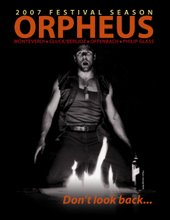Opera in Hell
 Besides the four operas playing at Glimmerglass about Orpheus, there have been many other operas about the legendary poet, the Greek Underworld, Christian Hell, and Hell's posterboy the Devil.
Besides the four operas playing at Glimmerglass about Orpheus, there have been many other operas about the legendary poet, the Greek Underworld, Christian Hell, and Hell's posterboy the Devil.
Orpheus
An astounding number of operas feature the Orpheus myth itself, a popular subject for an opera when the genre was in its infancy. Most operas were based on Greek mythology, so the story of Orpheus, a poet and musician of epic proportion, truly lends itself to a sung musical story.  Two of the most popular examples of these early operas are Monteverdi's L'Orfeo (1607) and Peri's Euridice (1600), but the earliest well-known example is Politan's 1480 Fabula di Orfeo (The Fable of Orpheus.)
Two of the most popular examples of these early operas are Monteverdi's L'Orfeo (1607) and Peri's Euridice (1600), but the earliest well-known example is Politan's 1480 Fabula di Orfeo (The Fable of Orpheus.)
Over the years, so many composers set Orpheus operas that yet more composers began to parody them, such as P.D. Deshayes who parodied Gluck's famous work. Offenbach's Orpheus in the Underworld (1858) is certainly the best known and most performed Orpheus satire.
Despite the existence of over 40 operas on the subject of Orpheus, interest in the myth continued into the 20th and 21st centuries. Composers like Darius Milhaud, Harry Birtwistle, Philip Glass set the opera, Stravinsky wrote a ballet, and most recently, Leslie Burrs and John A. Williams created a show re-telling Orpheus legend set during the time of the Underground Railroad.
 Two of the most popular examples of these early operas are Monteverdi's L'Orfeo (1607) and Peri's Euridice (1600), but the earliest well-known example is Politan's 1480 Fabula di Orfeo (The Fable of Orpheus.)
Two of the most popular examples of these early operas are Monteverdi's L'Orfeo (1607) and Peri's Euridice (1600), but the earliest well-known example is Politan's 1480 Fabula di Orfeo (The Fable of Orpheus.)Over the years, so many composers set Orpheus operas that yet more composers began to parody them, such as P.D. Deshayes who parodied Gluck's famous work. Offenbach's Orpheus in the Underworld (1858) is certainly the best known and most performed Orpheus satire.
Despite the existence of over 40 operas on the subject of Orpheus, interest in the myth continued into the 20th and 21st centuries. Composers like Darius Milhaud, Harry Birtwistle, Philip Glass set the opera, Stravinsky wrote a ballet, and most recently, Leslie Burrs and John A. Williams created a show re-telling Orpheus legend set during the time of the Underground Railroad.
Orpheus' Influence
 Fidelio by Beethoven revolves around the rescue of Florestan from an underground prison by his wife Leonore.
Fidelio by Beethoven revolves around the rescue of Florestan from an underground prison by his wife Leonore. - In Mozart's Die Zauberflöte, Tamino rescues Pamina from imprisonment with only a magic flute at his disposal.
- Wagner, who was heavily influenced by folklore and myth. The lead males in Der Meistersinger von Nürnberg and Tannhäuser are both singers with the ability to charm their audience.
Christian Hell or the Greek Underworld
 Rameau, an 18th century opera composer whose focus was often Greek myth, set Castor and Pollux and Hippolyte et Aricie, both of which involve underworld scenes.
Rameau, an 18th century opera composer whose focus was often Greek myth, set Castor and Pollux and Hippolyte et Aricie, both of which involve underworld scenes.- Don Giovanni by Mozart features the legendary lover Don Juan, who gets swallowed up by Hell.
- Rachmaninov's Francesco da Remini is set in the set in the second circle of Hell a la Dante's Inferno.
- Too Many Sopranos by Edwin Penhorwood--a cult classic amongst college voice students, the opera follows the hijinks of four sopranos trying to get get into Heaven's already full choir.
Devil of a Time
 Faust by Gounod (1859) French grand opera, based on the wildly popular book by Goethe which set to poetry the legend of Faust, a man who sold his soul to the devil. Similar operas followed, including Mefistofeles by Boito and Damnation de Faust by Berlioz.
Faust by Gounod (1859) French grand opera, based on the wildly popular book by Goethe which set to poetry the legend of Faust, a man who sold his soul to the devil. Similar operas followed, including Mefistofeles by Boito and Damnation de Faust by Berlioz.- The Devil and Kate (1899) by Dvorak is a comedy based on Czech folk legend that parallels the Orpheus myth. A peasant girl is lured to Hell by the devil and is rescued by her shepherd love.
- The Devil and Daniel Webster (1939) by Douglas Moore tell the story of another man, this time a politician from New Hampshire, who sells his soul to the devil and what happens when the devil comes to collect.
- Paradise Lost (1975) by Krzysztof Penderecki depicts the courtship, marriage and temptation of Adam and Eve, with author John Milton as commentator. The piece uses semitones and is designed in the style of a Renaissance Florentine court drama.
All images courtesy of NYPL Digital Gallery.
